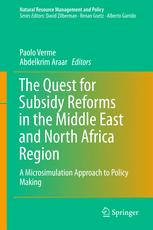

Most ebook files are in PDF format, so you can easily read them using various software such as Foxit Reader or directly on the Google Chrome browser.
Some ebook files are released by publishers in other formats such as .awz, .mobi, .epub, .fb2, etc. You may need to install specific software to read these formats on mobile/PC, such as Calibre.
Please read the tutorial at this link. https://ebooknice.com/page/post?id=faq
We offer FREE conversion to the popular formats you request; however, this may take some time. Therefore, right after payment, please email us, and we will try to provide the service as quickly as possible.
For some exceptional file formats or broken links (if any), please refrain from opening any disputes. Instead, email us first, and we will try to assist within a maximum of 6 hours.
EbookNice Team

Status:
Available0.0
0 reviewsThis book is an analysis of energy and food subsidies in the MENA region between 2010 and 2014. Using the World Bank’s proprietary SUBSIM model, the book studies the distribution of subsidies and the simulation of subsidy reforms across eight countries within in a partial equilibrium framework. The distributional analysis of subsidies provides information on who benefits from existing subsidies, while the simulations of subsidy reforms provide information on the outcomes of the reforms in terms of government budget, household welfare, poverty, inequality, and the trade-offs between these outcomes. This focus provides governments with the essential information they need to make decisions on subsidy reforms and consumers with a clear sense of which programs and reforms are successful.
The book highlights the historical roots of subsidies, the real trigger of subsidy reforms, and the complexity of subsidy reforms. It discusses the pros and cons of radical and gradualist approaches to reforms, the use of compensation mechanisms and their implications, the advantages and disadvantages of public information campaigns, the political economy of targeting different economic populations, the political timing of reforms, and whether, overall, the reforms observed in the MENA region have been successful. The first book on subsidies in the MENA region that is based on primary micro data, this book is useful for researchers and graduate students studying political economy and working with microsimulation modelling instruments as well as government officials engaged in subsidies reforms, research institutes and private consulting groups advising governments on subsidy reforms.